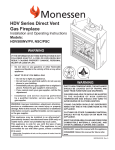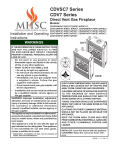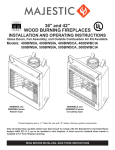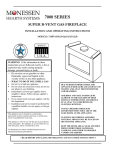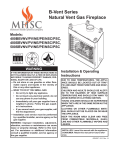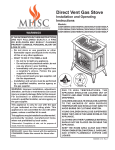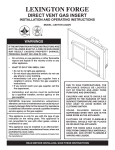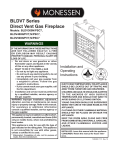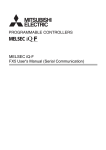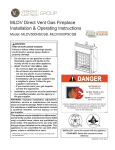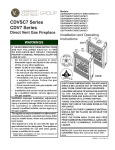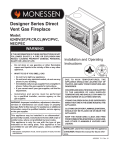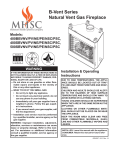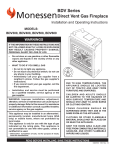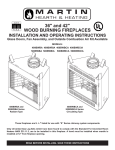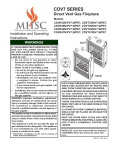Download Monessen Hearth B-VENT SBV500 Operating instructions
Transcript
B-VENT SERIES NATURAL VENT GAS FIREPLACE INSTALLATION AND OPERATING INSTRUCTIONS MODELS: BBV400 SBV400 SBV500 WARNINGS IF THE INFORMATION IN THESE INSTRUCTIONS ARE NOT FOLLOWED EXACTLY, A FIRE OR EXPLOSION MAY RESULT CAUSING PROPERTY DAMAGE, PERSONAL INJURY OR LOSS OF LIFE. – Do not store or use gasoline or other flammable vapors and liquids in the vicinity of this or any other appliance. – WHAT TO DO IF YOU SMELL GAS DUE TO HIGH TEMPERATURES, THE APPLIANCE SHOULD BE LOCATED OUT OF TRAFFIC AND AWAY FROM FURNITURE AND DRAPERIES. • Do not try to light any appliance. • Do not touch any electrical switch; do not use any phone in your building. • Immediately call your gas supplier from a neighbor's phone. Follow the gas supplier's instructions. • If you cannot reach your gas supplier, call the fire department. CHILDREN AND ADULTS SHOULD BE ALERTED TO THE HAZARDS OF HIGH SURFACE TEMPERATURE AND SHOULD STAY AWAY TO AVOID BURNS OR CLOTHING IGNITION. Installation and service must be performed by a qualified installer, service agency or the gas supplier. CLOTHING OR OTHER FLAMMABLE MATERIAL SHOULD NOT BE PLACED ON OR NEAR THE APPLIANCE. WARNING: Improper installation, adjustment, alteration, services or maintenance can cause injury or property damage. Refer to this manual. For assistance or additional information consult a qualified installer, service agency or the gas supplier. KEEP THE ROOM AREA CLEAR AND FREE FROM COMBUSTIBLE MATERIALS, GASOLINE, AND OTHER FLAMMABLE VAPORS AND LIQUIDS. – YOUNG CHILDREN SHOULD BE SUPERVISED WHEN THEY ARE IN THE SAME ROOM AS THE APPLIANCE. READ BEFORE INSTALLING. SAVE THESE INSTRUCTIONS CONTENTS Thank you and congratulations on your purchase of a Monessen Hearth Systems Fireplace. PLEASE READ THE INSTALLATION AND OPERATION INSTRUCTIONS BEFORE USING THE APPLIANCE! IMPORTANT: Read all instructions and warnings carefully before starting installation. Failure to follow these instructions may result in a possible fire hazard and will void the warranty. Code Approval .................................................. 5 Final Installation ............................................. 23 Rock Wool Placement ................................. 23 Log Placement ............................................ 23 Lava Rock and Ember Placement .............. 23 Pre-Installation Information Installing Above 2000 Feet ............................ 6 Orifice Sizes, Pressures and BTUs ............... 6 Before You Install .......................................... 6 Fireplace Framing ......................................... 7 Fireplace Dimensions ................................... 8 Fireplace Location ....................................... 10 Operating Instructions ................................... 24 What To Do If You Smell Gas ...................... 24 Lighting Pilot for the First Time ................... 24 Lighting Pilot ............................................... 25 Lighting Burner ............................................ 26 Lighting Electronic IGN ............................... 27 To Turn Off Gas ........................................... 27 Clearances .......................................................11 Cleaning and Maintenance ............................ 28 Burner, Pilot and Control Compartment ...... 28 Pilot Flame .................................................. 28 Burner ......................................................... 28 Burner Flame .............................................. 28 Vent System ................................................ 29 Logs ............................................................ 29 Rock Wool .................................................. 29 Important Safety Information .......................... 3 Product Features .............................................. 5 Securing Fireplace to Floor or Framing ....... 12 Installation Information .................................. 13 Vent Installation .............................................. 13 Installation Precautions ............................... 13 Installation Planning .................................... 14 Outside Combustion Air Precautions and Recommendations ................................... 16 Combustion Air Assembly ............................. 17 Fireplace Installation ...................................... 18 Check Gas Type.......................................... 18 Installing Gas Piping to Fireplace/Burner System Location ......................................... 18 Replacement Parts ......................................... 30 Firebox Components ................................... 30 Logs ............................................................ 31 Standing Pilot - Millivolt Control .................. 32 Electronic Ignition ........................................ 33 Troubleshooting ............................................. 34 Warranty ...........................................Back Cover Checking Gas Pressure ................................. 20 Electrical Installation ..................................... 21 Electrical Wiring .......................................... 21 Remote Wall Mounted Switch ..................... 21 Electronic Pilot Ignition Wiring .................... 22 2 62D4036 IMPORTANT SAFETY INFORMATION WARNING INSTALLER Please leave these instructions with the appliance. OWNER Please retain these instructions for future reference. • Read this owner’s manual carefully and completely before trying to assemble, operate, or service this fireplace. • Any change to this fireplace or its controls can be dangerous. • Improper installation or use of this fireplace can cause serious injury or death from fire, burns, explosions, electrical shock and carbon monoxide poisoning. This fireplace is a decorative gas appliance. This fireplace must be properly installed by a qualified service person. CARBON MONOXIDE POISONING: Early signs of carbon monoxide poisoning are similar to the flu with headaches, dizziness and/or nausea. If you have these signs, the fireplace may not have been installed properly. Get fresh air at once! Have the fireplace inspected and serviced by a qualified service person. Some people are more affected by carbon monoxide than others. These include pregnant women, people with heart or lung disease or anemia, those under the influence of alcohol, and those at high altitudes. Propane/LP gas and natural gas are both odorless. An odormaking agent is added to each of these gases. The odor helps you detect a gas leak. However, the odor added to these gases can fade. Gas may be present even though no odor exists. Make certain you read and understand all warnings. Keep this manual for reference. It is your guide to safe and proper operation of this fireplace. 1. This appliance is only for use with the type of gas indicated on the rating plate. This appliance is not convertible for use with other gases unless a certified kit is used. 2. For propane/LP fireplace, do not place propane/LP supply tank(s) inside any structure. Locate propane/LP supply tank(s) outdoors. To prevent performance problems, do not use propane/LP fuel tank of less than 100 lbs. capacity. 3. If you smell gas • shut off gas supply. • do not try to light any appliance. • do not touch any electrical switch; do not use any phone in your building . • immediately call your gas supplier from a neighborʼs phone. Follow the gas supplierʼs instructions. 4. Never install the fireplace • in a recreational vehicle • where curtains, furniture, clothing, or other flammable objects are less than 42" from the front, top, or sides of the fireplace • in high traffic areas • in windy or drafty areas 5. This fireplace reaches high temperatures. Keep children and adults away from hot surfaces to avoid burns or clothing ignition. Fireplace will remain hot for a time after shutdown. Allow surfaces to cool before touching. 6. Carefully supervise young children when they are in the room with fireplace. 7. Do not modify fireplace under any circumstances. Any parts removed for servicing must be replaced prior to operating fireplace. 8. Turn fireplace off and let cool before servicing, installing, or repairing. Only a qualified service person should install, service, or repair the fireplace. Have burner system inspected annually by a qualified service person. 9. You must keep control compartments, burners, and circulating air passages clean. More frequent cleaning may be needed due to excessive lint and dust from carpeting, bedding material, pet hair, etc. Turn off the gas valve and pilot light before cleaning fireplace. 10. Have venting system inspected annually by a qualified service person. If needed, have venting system cleaned or repaired. See Cleaning and Maintenance, page 32. 11. Keep the area around your fireplace clear of combustible materials, gasoline, and other flammable vapor and liquids. Do not run fireplace where these are used or stored. Do not place items such as clothing or decorations on or around fireplace. Continued on page 4 62D4036 3 IMPORTANT SAFETY INFORMATION 13. Never place anything on top of fireplace. 17. When the appliance is installed directly on carpeting, tile or other combustible material other than wood flooring, you must set appliance on a metal or wood panel or hearth pad extending the full width and depth of the appliance. 14. Do not use any solid fuels (wood, coal, paper, cardboard, etc.) in this fireplace. Use only the gas type indicated on rating plate. 18. Do not use fireplace if any part has been exposed to or has been under water. Immediately call a qualified service person to arrange for replacement of the unit. 15. This appliance, when installed, must be electrically grounded in accordance with local codes or in the absence of local codes, with the National Electrical Code, ANSI/NFPA 70, or the Canadian Electrical Code, CSA C22.1. 19. Do not operate fireplace if any log is broken. 12. Do not use this fireplace to cook food or burn paper or other objects. 16. Do not obstruct the flow of combustion and ventilation air in any way. Provide adequate clearances around air openings into the combustion chamber along with adequate accessibility clearance for servicing and proper operation. IMPORTANT: PLEASE READ THE FOLLOWING CAREFULLY It is normal for fireplaces fabricated of steel to give off some expansion and/or contraction noises during the start up or cool down cycle. Similar noises are found with your furnace heat exchanger or car engine. We suggest that our gas hearth products be installed and serviced by professionals who are certified in the U.S. by the National Fireplace Institute® (NFI) as Gas Specialists. WARNING www.nficertified.org 4 20. Do not use a blower fireplace, heat exchanger fireplace, or any other accessory not approved for use with this fireplace. 21. The fireplace is not intended for use with a thermostat. 22. This appliance must be installed with draft hood in same atmospheric pressure zone as the combustion air inlet to the appliance. 22. For Massachusetts Residents Only: This product must be installed by a licensed plumber or gas fitter when installed within the Commonwealth of Massachusetts. Flexline installation must not exceed 36". IMPORTANT: PLEASE READ THE FOLLOWING CAREFULLY It is not unusual for gas fireplace to give off some odor the first time it is burned. This is due to the manufacturing process. Please ensure that your room is well ventilated during burn off — open all windows. It is recommended that you burn your fireplace for at least ten (10) hours the first time you use it. WARNING Continued from page 3 Never connect unit to private (non-utility) gas wells. This gas is commonly known as wellhead gas. Proposition 65 Warning: Fuels listed in gas, wood burning or oil fired appliances, and the products of combustion of such fuels, contain chemicals known to the State of California to cause cancer, birth defects and other reproductive harm. California Health and Safety Code Sec. 25249.6 62D4036 PRODUCT FEATURES AND CODE APPROVAL PRODUCT SPECIFICATIONS • This appliance has been certified for use with either natural or propane gas. See appropriate data plates. • This appliance is not for use with solid fuels. • The appliance must be installed in accordance with local codes if any. If none exist use the current installation code. ANSI Z223.1/NFPA 54 in the USA, CAN/CGA B149 in Canada. • The appliance must be properly connected to a venting system. • The appliance is not approved for closet or recessed installations. 1/2" Nailing Flange Gas Control (not shown) 5/8" Nailing Flange 1/2" Figure 1 - BBV/SBV Fireplace Nailing Flage CODE APPROVAL These appliances have been tested by CSA and found to comply with the established standards for VENTED GAS FIREPLACES in the USA and Canada as follows: LISTED VENTED GAS FIREPLACE TESTED TO: ANSI Z21.50-2000•CSA 2.22-2000 62D4036 5 PRE-INSTALLATION INFORMATION INSTALLING ABOVE 2000 FEET • In the USA, the appliance must be derated 4% for every 1,000 ft above 2,000 ft elevations. • In Canada, these appliances are certified for altitudes of 0 – 2000 ft, and must be de-rated by 10 percent for installations between 2000 and 4,500 ft. (derate an additional 4% for every 1,000 ft. above 4,500 ft. elevations). ORIFICE SIZES, PRESSURES AND BTUs NATURAL GAS Manifold Press: (W.C.) Maximum Supply Pressure Minimum Supply Pressure PROPANE GAS Manifold Press: (W.C.) Maximum Supply Pressure Minimum Supply Pressure 3.5" 10.5" 4.5" Model Number BBV400 10" 13" 11" SBV400 SBV500 Natural Propane Natural Propane Natural Propane Max. Btu/hr Input 22,000 22,000 29,000 29,000 31,500 31,500 Min. Btu/hr Input 16,000 14,500 16,500 16,300 19,000 20,000 #43 #55 #41 #53 #37 #52 Burner Orifice size (as shipped) BEFORE YOU START Read this homeowner manual thoroughly and follow all instructions carefully. Inspect all contents for shipping damage and immediately inform your dealer if any damage is found. Do not install any unit with damaged, incomplete, or substitute parts. Check your packing list to verify that all listed parts have been received. You should have the following: • Fireplace (Firebox and Burner System) • White Toggle Switch (1) • Log Set • Plastic Bag (1) • Volcanic Rock • Switch Cover Plate (1) • Ziplock Bag 2"x3"x3" • Rock Wool ITEMS REQUIRED FOR INSTALLATION Tools: • Phillips Screwdriver • Hammer • Saw and/or saber saw • Level • Measuring Tape • Electric Drill and Bits • Pliers • Square • Pipe Wrench 6 Building Supplies: • Framing Materials • Wall Finishing Materials • Caulking Material (Noncombustible) • Fireplace Surround Material (Noncombustible) • Piping Complying with Local Codes • Tee Joint • Pipe Sealant Approved for use with Propane/LPG (Resistant to Sulfur Compounds) 62D4036 PRE-INSTALLATION INFORMATION FIREPLACE FRAMING Firebox framing can be built before or after the appliance is set in place. Construct firebox framing following Figure 2 and the chart below for your specific installation requirements. See Figure 3 on Page 8 for firebox dimensions. The framing headers may rest on the top of the firebox standoffs. WARNING The firebox may be installed directly on a combustible floor or raised on a platform of an appropriate height. When the firebox is installed directly on carpeting, tile, or other combustible material, other than wood flooring, the firebox shall be installed on a metal or wood panel extending the full width and depth of the enclosure. Do not fill spaces around firebox with insulation or other materials. This could cause a fire. H D C G F A B C D E F G H A E BBV400 SBV400 SBV500 401/2" 401/2" 461/2" 401/4" 401/4" 401/4" 313/8" 2413/16" 3013/16" 161/8" 131/2" 161/2" 611/4" 677/8" 737/8" 305/8" 34" 37" 141/2" 211/2" 211/2" 433/8" 48" 521/4" C Corner Installation G A /2" or 5/8" 1 Inside Chase Installation C G B A A Stud Location 62D4036 Recessed Installation Figure 2 - Framing Dimensions 7 PRE-INSTALLATION INFORMATION FIREPLACE DIMENSIONS BBV400 Center Line 4" 313/8" B-Vent 141/2" 14" Framing 8" Dimension TOP VIEW /2" or 5/8" Drywall Spacers /2" or 5/8" Drywall Spacers 1 1 40" 401/4" 95/8" Air Kit 34" 211/2" Framing Dimension 163/4" 6" 23/16" 71/4" Electrical/ Gas Access SIDE VIEW B C D Framing Dimension FRONT VIEW Figure 3 - BBV400 Dimensions 8 62D4036 PRE-INSTALLATION INFORMATION FIREPLACE DIMENSIONS SBV400 and SBV500 SBV400 2413/16" 36" 40" 401/2" A B C D SBV500 3013/16" 42" 46" 461/2" NOTE: For easier installation on SBV400 and SBV500 units, place gas supply pipe 6" to 8" inside unit. Measure from the center of the gas knock-hole located at the bottom of the left side. 6" B-Vent A 211/2" 21" Framing Dimension Center Line 137/16" 61/2" TOP VIEW /2" or 5/8" Drywall Spacers /2" or 5/8" Drywall Spacers 1 1 40" 401/4" Framing Dimension 95/8" Air Kit 34" 211/2" 163/4" 6" 23/16" 141/4" Electrical/ Gas Access SIDE VIEW B C D Framing Dimension FRONT VIEW Figure 4 - SBV400 and SBV500 Dimensions 62D4036 9 PRE-INSTALLATION INFORMATION FIREPLACE LOCATION Plan for the installation of your appliance. This includes determining where the unit is to be installed, the vent configuration to be used, framing and finishing details, and whether any optional accessories (i.e. wall switch, or remote control) are desired. Consult your local building code agency to ensure compliance with local codes, including permits and inspections. The following factors should be taken into consideration: • Clearance to side-wall, ceiling, woodwork, and windows. Minimum clearances to combustibles must be maintained. • This fireplace may be installed along a wall, across a corner, or use an exterior chase. • Location should be out of high traffic areas and away from furniture and draperies due to heat from appliance. • Never obstruct the front opening of the fireplace. • Do not install in the vicinity where gasoline or other flammable liquids may be stored. • Vent pipe routing. See Venting section found in this manual for allowable venting configurations. • These units can be installed in a bedroom. See National Fuel Gas Code ANSI Z233.1/NFPA 54 — (current edition), the Uniform Mechanical Code — (current edition), and Local Building Codes for specific installation requirements. 10 62D4036 CLEARANCES WARNING CLEARANCES TO COMBUSTIBLES Follow these instructions carefully to ensure safe installation. Failure to follow instructions exactly can create a fire hazard. The appliance cannot be installed on a carpet, tile or other combustible material other than wood flooring. If installed on carpet or vinyl flooring, the appliance shall be installed on a metal, wood or noncombustible material panel extending full width and depth of the appliance. 72" Minimum 12" Maximum Depth 8" Minimum Minimum 3" From Both Side Walls to Opening Figure 5 - Clearances 62D4036 11 SECURING FIREPLACE TO FLOOR OR FRAMING The fireplace must be secured to the floor and/or to framing studs as shown in Figure 6 . Use two (2) wood screws or masonry/ concrete screws to secure fireplace to the floor. Use four (4) screws to attach fireplace to framing. The side brackets are adjustable from 1/2" to 5/8" to accommodate different thickness of material. Framing 1/2" Nail Flange Framing Screws 5/8" Nail Flange 1/2" Nail Flange Screws 1/2" Nail Flange 5/8" Nail Flange Screws 1/2" Nail Flange Figure 6 - Securing Fireplace to Floor and Framing Studs 12 62D4036 INSTALLATION INFORMATION FINISHING MATERIAL WARNING NOTE: Any remote wiring (i.e. remote control and wall switch) must be done prior to final finishing to avoid costly reconstruction. Never obstruct or modify the air inlet. This may create a fire hazard. Only noncombustible materials (i.e. brick, tile, slate, steel, or other materials with a UL fire rating of Zero) may be used to cover the black surface of the appliance. A 300°F minimum adhesive may be used to attach facing materials to the black surface. If joints between the finished wall and the fireplace surround are sealed, a 300°F minimum sealant material (General Electric RTV103 or equivalent) must be used. Read all instructions completely and thoroughly before attempting installation. Failure to do so could result in serious injury, property damage or loss of life. Operation of improperly installed and maintained venting system could result in serious injury, property damage or loss of life. NOTICE WARNING VENT INSTALLATION Failure to follow these instructions will void the warranty. INSTALLATION PRECAUTIONS Consult local building codes before beginning the installation. The installer must make sure to select the proper vent system for installation. Before installing vent kit, the installer must read this fireplace manual and vent kit instructions. Only a qualified installer/service person should install venting system. The installer must follow these safety rules: • Wear gloves and safety glasses for protection. • Use extreme caution when using ladders or when on rooftops. • Be aware of electrical wiring locations in walls and ceilings. The following actions will void the warranty on your venting system: • Installation of any damaged venting component. • Unauthorized modification of the venting system. • Installation of any component part not manufactured or approved by Monessen Hearth Systems • Installation other than permitted by these instructions. 62D4036 13 VENT INSTALLATION INSTALLATION PLANNING “B” VENT PIPE See venting installation instructions provided by the B-Vent manufacturer. Note: This APPLIANCE MUST BE INSTALLED using “B” vent type pipe that has been listed by a nationally recognized testing agency. See B-Vent Pipe Sizing chart for proper elbow offset runs. BBV400/400BBV 4" B-VENT PIPE SIZING SBV400/400SBV 6" SBV500/500SBV 6" Locate chimney center line dimension from a combustible back wall. See Figures 3 and 4, page 9. • Minimum vertical chimney height - 8' • Minimum height with two (2) 90° elbows - 8' • Elbow requirements allow a maximum of two (2) 90° elbows or four (4) 45° elbows per installation. Note: Two (2) 45° elbows = One (1) 90° elbow • Horizontal run must never exceed 50% of the height of the vent system. 14 62D4036 VENT INSTALLATION FIRESTOP INSTALLATION To position firestop see Figures 9 and 10. Only one (1) firestop required per frame. NOTE: A firestop is not required at the roof. Nails Joist Firestop Spacer Joist Firestop Spacer Nails NOTICE Figure 10 - Installing Firestop In Ceiling When installing in a chase, you should insulate the chase as you would the outside walls of your home. This is especially important in cold climates. Insulation should be considered a combustible material. Maintain proper clearances to all combustible materials. NOTICE Figure 9 - Installing Firestop In Attic Treatment of firestops and construction of the chase may vary from building type to building type. These instructions are not substitutes for the requirements of local building codes. You must follow all local building codes. 62D4036 15 OUTSIDE COMBUSTION AIR PRECAUTIONS AND RECOMMENDATIONS Note: The use of outside air for combustion is optional unless required by building codes. It is only necessary to supply outside combustion air to one side of fireplace. Use model OAC4 combustion air kit (see page 17). Duct Extended to Miss Joist 1. Avoid extremely long runs and numerous turns in duct leading from fireplace to combustion air assembly. These conditions increase the resistance to free flow of air through duct. See Figures 11 and 12. 2. Locate combustion air assembly at an exterior location. Make sure the location cannot be accidentally blocked. Locate assembly above snow line to prevent snow from blocking assembly. 3. Never mount combustion air inlet assembly in garage or storage area where combustible fumes (gasoline) might be drawn into fireplace. To Outside Wall Figure 11 - Installing Unit Above Basement or Crawl Space 4. Combustion air may be drawn from crawl space under house when adequate supply of air is provided by open ventilation. See Figure 11. Note: Never take combustion air from attic space or garage space. Note: Install outside combustion air ONLY ON LEFT-HAND SIDE of fireplace. Inlet Grill in Soffit (Overhag) 8' Maximum Figure 12 - Installing Unit on Concrete Slab with Optional Outside Air Runs 16 62D4036 MODEL OAC-4 COMBUSTION AIR ASSEMBLY 1. Remove the cover plate from the 4" outlet opening location on the left outside of the fireplace. 2. Place starting collar (4") into hole on left side of fireplace. Fireplace shortest side of air starting collar through fireplace outer wrap. Fasten starting collar in place with four (4) sheet metal screws provided. See Figure 13. WARNING COMBUSTION AIR ASSEMBLY DO NOT remove the cover if the outside air will not be connected. 3. Cut a 6" diameter opening for model OAC-4 in the outside wall covering where the outside vent is to be located. See Figure 15. 4. Select and cut a piece of duct long enough to attach to the fireplace and stick out at least 3" beyond the face of the wall to which the OAC-4 inlet air vent will be attached. Cut duct with a standard pocket knife. See Figure 14. Left Side of Fireplace WARNING Note: The air starting collar extends through the fireplace outer wrap. When the air starting collar is securely attached, it will form a seal against the fireplace wall. Do not use a combustible duct. Always use UL Listed Class 0 or 1 duct material. If necessary to splice duct, use Model 403 duct connector to splice duct sections. OAC-4 Starting Collar Air Starting Collar Screws Duct Sheet Metal Screws Left Side of Fireplace Shorter End of Air Starting Collar Figure 14 - Attaching Outside Duct to Starting Collar Figure 13 - Attaching Outside Air Starting Collar to Left Side of Fireplace 6" Diameter Hole Screw 5. If using insulating duct, push the insulation back from one end of the duct approximately 2". See Figure 15. Nail Holes 6. Slip the exposed end of the duct over the starting collar on the fireplace. 7. Using the sheet metal screws provided, secure the duct end to the collar attached to the fireplace. 8. Nail or screw the combustion air assembly to the surface of the wall. Duct Extending 3"min. AK-4 Inlet Air Vent Screws Figure 15 - Combustion Air Assembly for Model No. OAC-4 62D4036 17 FIREPLACE INSTALLATION CHECK GAS TYPE Use proper gas type for the fireplace you are installing. If you have conflicting gas type, do not install fireplace. See dealer where you purchased the fireplace for proper fireplace according to your gas type. Before installing, make sure you have the items listed below. • External regulator (supplied by installer) • Tee joint • Piping (check local codes) • Pipe wrench • Sealant (resistant to propane/LP gas) WARNING INSTALLATION ITEMS NEEDED A qualified installer or service person must connect appliance to gas supply. Follow all local codes. CAUTION INSTALLING GAS PIPING TO FIREPLACE LOCATION For propane/LP units, never connect fireplace directly to the propane/LP supply. This burner system requires an external regulator (not supplied). Install the external regulator between the burner system and propane/LP supply. • Test gauge connection* • Sediment trap (optional but recomended) • approved flexible gas line with gas connector (if allowed by local codes — not provided) * A CSA design-certified equipment shutoff valve with 1/8" NPT tap is an acceptable alternative to test gauge connection. Purchase the CSA design-certified equipment shutoff valve from your dealer. 100 gal. (min) Propane/LP Supply Tank CAUTION External Regulator Use only new black iron or steel pipe. Internally tinned copper or copper tubing can be used per National Fuel Code, section 2.6.3, providing gas meets hydrogen sulfide limits, and where permitted by local codes. Gas piping system must be sized to provide minimum inlet pressure (listed on data plate) at the maximum flow rate (BTU/ hr). Undue pressure loss will occur if the pipe is too small. WARNING For propane/LP connections only, the installer must supply an external regulator. The external regulator will reduce incoming gas pressure. You must reduce incoming gas pressure to between 11 and 13 inches of water. If you do not reduce incoming gas pressure, burner system regulator damage could occur. Install external regulator with the vent pointing down as shown in Figure 16. Pointing the vent down protects it from freezing rain or sleet. External regulators may be necessary for natural gas. One- or two-pound systems will damage this appliance and may cause fire hazzard. Vent Pointing Down Figure 16 - External Regulator with Vent Pointing Down (Propane/LP Only) When using copper or flex connectors use only fittings approved for gas connections. The gas control inlet is 3/8" NPT. 18 62D4036 Only persons licensed to work with gas piping may make the necessary gas connections to this appliance. CAUTION WARNING FIREPLACE INSTALLATION A manual shutoff valve must be installed upstream of the appliance. Union tee and plugged 1/8" NPT pressure tapping point should be installed upstream of the appliance. See Figure 17. NOTE : The gas line connection may be made using 1/2" rigid tubing or an approved flex connector. Since some municipalities have additional local codes it is always best to consult your local authorities and the current edition of the National Fuel Gas Code ANSI.Z223.1, NFPA54. In Canada CAN/CGA-B149 (1 or 2) Installation Code. A listed manual shutoff valve must be installed upstream of the appliance. Union tee and plugged 1/8" NPT pressure tapping point should be installed upstream of the appliance. See Figure 17. Check your building codes for any special requirements for locating equipment shutoff valve to fireplaces. Apply pipe joint sealant lightly to male threads. This will prevent excess sealant from going into pipe. Excess sealant in pipe could result in clogged burner system valves. CAUTION IMPORTANT: Install main gas valve (equipment shutoff valve) in an accessible location. The main gas valve is for turning on or shutting off the gas to the fireplace. Use pipe joint sealant that is resistant to liquid petroleum (LP) gas. We recommend that you install a sediment trap/drip leg in supply line as shown in Figure 17. Locate sediment trap/drip leg where it is within reach for cleaning. Install in piping system between fuel supply and burner system. Locate sediment trap/drip leg where trapped matter is not likely to freeze. A sediment trap traps moisture and contaminants. This keeps them from going into the burner system gas controls. If sediment trap/drip leg is not installed or is installed wrong, burner system may not run properly. UL/CSA Design-Certified Equipment Shutoff Valve with 1/8" NPT Tap* Approved Flexible Gas Line Sediment Trap/Drip Leg Tee Joint Pipe Nipple Cap 3" Mi nim um Natural Gas From Gas Meter (5" W.C. to 10.5" W.C. Pressure) Propane/LP From External Regulator (11" W.C. to 13" W.C. Pressure) Figure 17 - Gas Connection 62D4036 19 CHECKING GAS PRESSURE Check gas type. The gas supply must be the same as stated on the applianceʼs rating decal. If the gas supply is different from the fireplace, STOP! Do not install the appliance. Contact your dealer immediately. 2. To ease installation, a 30" (mm) flex line with manual shut-off valve has been provided with on this appliance. Install and attach 1/2" gas line onto shut-off valve. 3. After completing gas line connection, purge air from gas line and test all gas joints from the gas meter to the fireplace for leaks. Use a solution of 50/50 water and soap or a gas sniffer. 4. To adjust flame height, turn HI/LO knob to HI to get maximum pressure to burner. Turn HI/LO knob to LO to get minimum pressure. 5. 20 To check gas pressures at valve, turn captured screw counter clockwise 2 or 3 turns and then place tubing to pressure gauge over test point. Turn unit to high. See Figure 18. After taking pressure reading, be sure and turn captured screw clockwise firmly to reseal. Do not over torque. Check test points for gas leaks. Pressure Test “IN” Pressure Test “OUT” HI/LO Knob Pilot Adjustment Screw Figure 18 - Gas Pressure Check at Gas Valve WARNING 1. Do not use open flame to check for gas leaks. 62D4036 ELECTRICAL INSTALLATION ELECTRICAL WIRING CAUTION WARNING Electrical connections should only be performed by a qualified, licensed electrician. Main power must be off when connecting to main electrical power supply or performing service. All wiring shall be in compliance with all local, city, and state codes. The appliance, when installed, must be electrically grounded in accordance with local codes, or in the absence of local codes, with the National Electrical Code ANSI/ NFPA 70 (latest edition) and Canadian Electrical Code, CSA C22.1. Label all wires before disconnecting when servicing controls. Wiring errors can cause improper and dangerous operation. Verify proper operation after servicing. REMOTE WALL MOUNTED SWITCH A remote wall switch and up to fifteen (15) feet of 18 Ga. wire may be used with this appliance. Attach the wall switch in a junction box at the desired location on the wall. See Figure 19. Do not extend beyond the wall switch wire length provided. NOTE: Extended lengths of wire may cause the fireplace not to function properly. Longer length of wire is permitted if the wire is made out of larger gauge (diameter) wire. Always check with local code. OPTIONAL REMOTE WALL SWITCH HI ON OFF PILOT LO TH TP TH/TP ON OFF RS SPILL SWITCH ON OFF OPTIONAL REMOTE WALL SWITCH WARNING ON Do not connect wall switch to AC (110V) circuit. 62D4036 OFF Figure 19 - Wiring Diagram for Wall Switch 21 ELECTRICAL INSTALLATION WARNING ELECTRONIC PILOT IGNITION WIRING Do not connect 110-120 VAC to the Remote Wall Switch. The appliance will malfunction or destroyed. Figure 20 - Electronic Ignition System Wiring Diagram REMOTE WALL SWITCH Position the wall switch. Do not extend beyond the 15' of wire. OPTIONAL DC REMOTE SYSTEMS These instructions replace the section entitled Hearth Mount in the Millivolt hand held remote instructions supplied with the remote. 1. Plug in remote connector wire to remote receiver. 2. Connect the wire terminal from the remote receiver. This replaces the 15' wall switch connection to the switch. See Figure 20. 3. Mount remote control receiver at junction box (for your wall switch). 22 62D4036 FINAL INSTALLATION ROCK WOOL PLACEMENT 1. Place rock wool on burner to provide glowing embers. For best results, pull the rock wool apart into pieces the size of a nickel or smaller. Burner 2. Distribute one layer of rock wool to cover the entire burner. See Figure 21. If the flame is blue and only in the center, turn off unit and let cool. After unit cools, remove logs. If the back holes are clear, add more rock wool to the center of the burner. Replace logs and check flame again. Save left over rock wool to refresh when cleaning later. Too much rock wool can disturb the flame and cause sooting on the glass or logs. Cover with Rock Wool Figure 21 - Placement of Rock Wool on Burner WARNING 3. Place the logs on the burner. See Log Placement below. Light unit and after 15 minutes, check burner flame and glow. See Burner Flame, page 28. Do not use the entire bag of rock wool to cover the burner. This could cause the flame to burn poorly and may lead to sooting. (#3) Top Left Log LOG PLACEMENT 1. Place rear log (#1) on grate assembly. Log should rest firmly on the two log mounting pins on the horizontal bars. See Figure 22. 2. Place top right log (#2) on the rear log. Rest the right back side of the log in the flat area of the rear log. Place the narrow front end of the log next to the center vertical grate bar. See Figure 22. (#2) Top Right Log (#1) Rear Log 3. Place the top left log (#3) on the rear log. Nest the forked end of the top left log into the fork or the rear log. Rest the narrow end of the top left log behind the center vertical grate bar. See Figure 22. Log Mounting Pins Flat Area LAVA ROCK AND EMBER PLACEMENT WARNING Sprinkle lava rock on the floor of the inner combustion chamber. Evenly distribute the rock. Do not pile the lava rock up in front of Left Vertical Grate Bar grate. Do not place lava rock on the burner. If desired, purchase optional embers to decorate the floor of the fireplace. Center Vertical Grate Bar Do not sprinkle the lava rock or ember chunks on top of the burner. This may cause potential sooting, glass breakage and a fire hazard. 62D4036 Right Vertical Grate Bar Figure 22 - Log Placement (BDV300, 400 shown) 23 OPERATING INSTRUCTIONS WARNING FOR YOUR SAFETY READ BEFORE LIGHTING If you do not follow these instruction exactly, a fire or explosion may result causing property damage, personal injury or loss of life. A. This appliance is equipped with a pilot which must be lit with an ignitor while following these instructions exactly. B. BEFORE OPERATING smell all around the appliance area for gas. Be sure to smell next to the floor because some gas is heavier than air and will settle on the floor. WHAT TO DO IF YOU SMELL GAS: • Turn off all gas to the appliance. • Open windows. • Do not attempt to light any appliance. • Do not touch any electric switch; do not use any phone in your building. • Immediately call your gas supplier from a neighbor's phone. Follow the gas supplier's instructions. • If you cannot reach your gas supplier, call the fire department. C. Use only your hand to push in, or turn the gas control knob. Never use tools. If the knob will not push in or turn by hand, don't try to repair it. Call a qualified service technician. Force or attempted repair may result in a fire or explosion. D. Do not use this appliance if any part of it has been under water. Immediately call a qualified service technician to inspect the appliance and to replace any part of the control system and any gas control that has been under water. INITIAL LIGHTING Purge air from the supply line as follows: • Open main shutoff valve. • Unscrew main pressure test point. • Leave inlet test screw open until gas comes in. • When gas is flowing, tighten inlet screw immediately. WARNING LIGHTING PILOT FOR THE FIRST TIME Never use an open flame to check for gas leak. LEAK TESTING 1. Follow the pipe from the gas supply line connection to the gas valve. Check connection for leaks with soap and water mixture. 2. Next check for gas leaks at the burner with soap and water mixture. 3. Check the pilot for gas leaks with soap and water mixture. 24 62D4036 OPERATING INSTRUCTIONS APPROVED LEAK TESTING METHOD You may check for gas leaks with the following methods only: • Soap and water solution • An approved leak testing spray DANGER • Electronic sniffer Never check for gas leak with open flame! WARNING LIGHTING PILOT FOR THE FIRST TIME If using a soap and water solution to test for leaks, DO NOT spray solution onto control body. NOTE: Remove any excessive pipe compound from the connections. Excessive pipe compound can set off electronic sniffers. Check for gas leaks in each of the following locations: • Pipe from the gas supply line connection to the gas valve • Burner connections • Field made joints / gas shutoff valve • Pilot • Factory made joints • Each joint or connection • All joints on valve and control body WARNING LIGHTING PILOT The control has an interlock device that does not allow the lighting of the fireplace up to the moment the safety device of the flame has not interrupted the gas flow. After that period of time (when the magnet is closed), it is possible to start the lighting operation. The gas control knob is designed to be operated by hand. DO NOT use any tools during this operation. Damaged knobs may result in serious injury. 1. Depress and turn knob counterclockwise to pilot position. If the pilot does not stay lit, repeat steps 1 and 2. PILOT F OF 2. Depress fully and hold pilot gas knob. The electronic ignitor will automatically ignite the pilot. Keep knob fully depressed for a few seconds. Release and check that pilot continues to burn. ON PIL OT Figure 23 - Pilot Position Continued on next page 62D4036 25 OPERATING INSTRUCTIONS LIGHTING BURNER 50 MAIN BURNER SWITCH The “ON/OFF” switch for the main burner can be found behind door of the fireplace. This switch allows you to turn on and to turn off the main burner without using the gas valve knob. Make sure the button is in the “ON” position to light the main burner. See Figure 24. LIGHTING THE BURNER Depress and turn the knob counterclockwise to the “ON” position. See Figure 25. It will take less than four (4) seconds for the burner to ignite. Figure 24 On/Off/RS Switch PIL O PIL T ON OFF Depress and turn knob to pilot position to keep burner off while maintaining the pilot light. See Figure 26. ON PILOT POSITION OT F PILOT Figure 25 - On Position OF PIL OT Figure 26 - Pilot Position TO TURN OFF GAS to “OFF” position. See Figure 27. PIL O T OFF Depress and turn knob clockwise ON PIL OT Figure 27 - Off Position 26 62D4036 OPERATING INSTRUCTIONS A. This appliance is equipped with an ignition device (Piezo) which automatically lights the pilot. Do NOT try to light the burner by hand. B. BEFORE OPERATING smell all around the appliance area for gas. Be sure to smell next to the floor because some gas is heavier than air and will settle on the floor. WARNING FOR YOUR SAFETY READ BEFORE LIGHTING If you do not follow these instructions exactly, a fire or explosion may result causing property damage, personal injury or loss of life. WARNING WHAT TO DO IF YOU SMELL GAS: Never use an open flame • Turn off all gas to the appliance. to check for gas leak. • Open windows. • Do not attempt to light any appliance. • Do not touch any electric switch; do not use any phone in your building. • Immediately call your gas supplier from a neighbor's phone. Follow the gas supplier's instructions. • If you cannot reach your gas supplier, call the fire department. C. Turn off all electric power to appliance. D. Do not use this appliance if any part of it has been under water. Immediately call a qualified service technician to inspect the appliance and to replace any part of the control system and any gas control that has been under water. LIGHTING ELECTRONIC IGN 1. STOP! Read the safety information above. 2. Set thermostat to lowest setting. Then turn switch to off position. ON PILOT HI 4. This appliance is equipped with an ignition device which automatically lights the burner. Do not try to light the burner by hand. LO OFF 3. Turn off all electric power to the appliance. Figure 28 - Electronic Gas Valve 5. Wait 5 minutes to clear out any gas. Then smell for gas, including near the floor. If you smell gas STOP! Follow “B” — What to Do if You Smell Gas above. If you do not smell gas, go to the next step. 6. Turn on all electric power to appliance. 7. Set thermostat to desired setting or turn RS-OFF-ON rocker switch to “ON”. 8. If the appliance will not operate, follow the instruction To Turn Off Gas below and call your service technician or gas supplier. TO TURN OFF GAS 1. Turn RS-OFF-ON rocker switch to “OFF”. 2. Turn off all electric power to the appliance if service is to be performed. 3. Close lower door. 62D4036 27 WARNING CLEANING AND MAINTENANCE Turn off gas before servicing fireplace. It is recommended that a qualified service technician perform these check-ups at the beginning of each heating season BURNER, PILOT AND CONTROL COMPARTMENT Keep the control compartment, logs, and burner areas surrounding the logs clean by vacuuming or brushing at least twice a year. Make sure the burner porting, pilot air opening and burner air opening are free of obstructions at all times. PILOT FLAME Thermocouple The flames from the pilot should be visually checked as soon as the heater is installed and periodically during normal operation. The pilot flame must always be present when the fireplace is in operation. See Figure 29. The pilot flame has three distinct flames, one engulfing the thermopile, one engulfing the thermocouple, and the other reaching to the main burner.. Thermopile BURNER Inspect area around the injector. Remove any lint or foreign material with a brush or vacuum. Figure 29 - Pilot Flame BURNER FLAME The flames from the burner should be visually checked as soon as the heater is installed and periodically during normal operation. In normal operation, at full rate, and after operating for about 15 to 30 minutes, the flame should be yellow and slightly taller than the rear log. See Figure 30. NOTE: The type of installation, vent system configuration, and wind effects may cause the flame patterns to vary. Figure 30 - Burner Flame Appearance 28 62D4036 CLEANING AND MAINTENANCE VENT SYSTEM The fireplace and venting system should be inspected before initial use and at least annually by a qualified field service person. Inspect the external vent cap on a regular basis to make sure that no debris is interfering with the airflow. Inspect entire venting system to ensure proper function. LOGS Leave logs installed in the fireplace for cleaning. Vacuum surface of the logs with a brush attachment. If logs must be removed for cleaning, handle carefully by holding gently at each end. Gloves are recommended to prevent skin irritation from ceramic fibers. If skin becomes irritated, wash gently with soap and water. Vacuum surface of logs with brush attachment or brush logs with a soft bristle brush (i.e. clean, dry paintbrush). To place logs back in the fireplace, see “Log Placement” found in the Final Installation section. NOTE: Do not use cleaning fluid to clean logs. ROCK WOOL Replace or add rock wool as required following installation instructions in the Final Installation section of this manual. 62D4036 29 ILLUSTRATED PARTS LISTS FIREBOX COMPONENTS 6 1 2 4a 4b 3 4c 5 7 30 62D4036 ILLUSTRATED PARTS LISTS FIREBOX COMPONENTS Item Description Qty BBV400/400BBV SBV400/400SBV SBV500/500SBV 1 Pull Screen Panel 2 61D0001 61D0001 61D0003 2 Refractory Side 2 n/a 61D0101 61D0101 3 Refractory Back 1 n/a 61D0102 61D0107 4a Left Refractory Floor 1 n/a 62D1015 62D2015 4b Middle Refractory Floor 1 n/a 62D1016 62D2016 4c Right Refractory Floor 1 n/a 62D1017 62D2017 FBBV400W n/a n/a Optional Field Installed Accessories 5 Firebrick Assembly 1 6 Outside Air Kit 1 OAC4 OAC4 OAC4 7 Black Glass Door Assembly 1 GD36BA GD36BA GD42BA 7 Polished Brass Glass Door Assembly 1 GD36PBA GD36PBA GD42PBA 7 Stainless Glass Door Assembly 1 GD36SSA GD36SSA GD42SSA LOGS Item Description Qty BBV400/400BBV SBV400/400SBV SBV500/500SBV 1 Rear Log 1 54D0121 54D0181 54D0339 2 Right Log 1 54D0147 54D0116 54D0361 3 Left Log 1 54D0146 54D0115 54D0360 3 1 2 62D4036 31 ILLUSTRATED PARTS LISTS STANDING PILOT — MILLIVOLT CONTROL 2C 1 2I 2T 2 5 6 3 4 7 9 8 11 12, 13 10 32 62D4036 ILLUSTRATED PARTS LISTS STANDING PILOT – MILLIVOLT CONTROL Item Description Qty BBV400NV BBV400PV SBV400NV SBV400PV SBV500NV SBV500PV 1 Gas Valve Assembly 1 37D0117 37D0118 37D0117 37D0118 37D0117 37D0118 2 Pilot Assembly 1 37D0018 37D0019 37D0018 37D0019 37D0018 37D0019 2C Replacement Thermocouple 1 37D1067 37D1067 37D1067 37D1067 37D1067 37D1067 2I Replacement Igniter and Wire 1 37D1069 37D1069 37D1069 37D1069 37D1069 37D1069 2T Replacement Thermopile 1 37D1068 37D1068 37D1068 37D1068 37D1068 37D1068 3 Burner Tube 1 62D4051 62D4051 62D4052 62D4052 62D4053 62D4053 4 Flexhose with Shutoff Valve 1 23D6046 23D6046 23D6046 23D6046 23D6046 23D6046 5 Rocker Switch 1 41D0048 41D0048 41D0048 41D0048 41D0048 41D0048 6 Piezo Igniter 1 14D0503 14D0503 14D0503 14D0503 14D0503 14D0503 7 Injector 1 62D3006 62D3005 62D3004 20H3143 62D3003 59D0094 8 Burner Assembly 1 54D0200 54D0200 54D0001 54D0001 54D0329 54D0329 9 Venturi 1 45D0600 45D0600 45D0600 45D0600 45D0600 45D0600 10 Wire Assembly 1 44D0500 44D0500 44D0500 44D0500 44D0500 44D0500 10 Wire Assembly 1 44D0501 44D0501 44D0501 44D0501 44D0501 44D0501 11 Spill Switch 1 62D0048 62D0048 073746 073746 073746 073746 Accessories 12 Remote Control On/Off 1 RCM/RCB RCM/RCB RCM/RCB RCM/RCB RCM/RCB RCM/RCB 13 Wall Switch Kit 1 MVWTS MVWTS MVWTS MVWTS MVWTS MVWTS BBV400 Conversion NG to LP 1 BBV400CKP — — — — — BBV400 Conversion LPG to NG 1 — BBV400CKN — — — — SBV400 Conversion NG to LP 1 — — SBV400CKP — — — SBV400 Conversion LPG to NG 1 — — — SBV400CKN — — SBV500 Conversion NG to LP 1 — — — — SBV500CKP — SBV500 Conversion LPG to NG 1 — — — — — SBV500CKN Conversion Kit (Not Shown) 62D4036 33 ILLUSTRATED PARTS LISTS ELECTRONIC IGNITION 1 2 5 3 4 6 8 7 11 12 9 34 10 62D4036 ILLUSTRATED PARTS LISTS ELECTRONIC IGNITION Item Description 1 2 3 4 Qty BBV400NV BBV400PV SBV400NV SBV400PV SBV500NV SBV500PV 37D0016 37D0017 37D0016 37D0017 37D0016 37D0017 37D0020 37D0021 37D0020 37D0021 37D0020 37D0021 Burner Tube 1 1 1 62D4051 62D4051 62D4052 62D4052 62D4053 62D4053 Flexhose with Shutoff Valve 1 23D6046 23D6046 23D6046 23D6046 23D6046 23D6046 41D0048 41D0048 41D0048 41D0048 41D0048 41D0048 62D3006 62D3005 62D3004 20H3143 62D3003 59D0094 54D0200 54D0200 54D0001 54D0001 54D0329 54D0329 45D0059 45D0059 45D0059 45D0059 45D0059 45D0059 54D2007 54D2007 54D2007 54D2007 54D2007 54D2007 37D0325 37D0325 37D0325 37D0325 37D0325 37D0325 37D0027 37D0027 37D0027 37D0027 37D0027 37D0027 62D0048 62D0048 073746 073746 073746 073746 Gas Valve Assembly Pilot Assembly 5 6 7 8 9 10 11 Rocker Switch Transformer 1 1 1 1 1 1 1 12 Spill Switch 1 Injector Burner Assembly Venturi Wire Assembly Ignition Module 62D4036 35 TROUBLESHOOTING STANDING PILOT IGNITION SYMPTOM POSSIBLE CAUSE 1. Spark ignitor A. Wire disconnected. will not light pilot after B. Defective ignitor. repeated trigC. No gas or low gas pressure. gering of piezo. D. No Propane/LPG in tank 2. Pilot will not A. Defective thermocouple stay lit after carefully following lighting instructions. B. Defective valve 3. Pilot burning, valve knob turned to “ON”, switch is turned to “ON” or “RS”, but burner will not ignite. A. Defective switch, wall switch, remote control or wire B. Pilot flame too small C. Defective or malfunctioning thermopile D. Defective valve ACTION A. Open door and check to make sure wire is connected to ignitor. B. Check for spark at electrode and pilot. If no spark and electrode wire is properly connected, replace pilot assembly. C. Check remote/manual shut off valve from fireplace. Low pressure can be caused by bent lines, restricted lines, low pressure line pressure. Consult with plumber or gas supplier. D. Check Propane/LPG tank. Refill tank. A. Check that thermocouple flame impinges on thermocouple. Clean and/or adjust pilot for maximum flame impingement. Ensure that the thermocouple connection at the gas valve is fully inserted and tight. Disconnect the thermocouple from the valve, place one millivolt lead wire on the tip of the thermocouple and the other meter lead wire on the thermocouple copper lead. Start the pilot and hold the valve knob in. If the millivolt reading is less than 15 mV, replace pilot assembly. B. If thermocouple is producing more than 15 mV, replace faulty valve. A. Check switch and wire for proper connection. Place jumper wires across terminals of switch. If burner comes on, replace defective switch.If the switch is OK, repeat the same procedure on remote control If burner comes on, replace remote control. Place jumper wire across wire at gas valves (terminals marked TH and TP/TH). If burner comes on, wires are faulty or connections are bad. Replace wire. B. If pilot flame is not close enough to the thermopile, adjust pilot flame. C. Check thermopile wire connections to make sure all are tight and that the thermopile is fully inserted into pilot assembly. Check thermopile with a millivolt meter. Connect leads to TP and TP/TH terminals on the control valve. If meter reading is below 325 mV, replace pilot assembly. D. Turn valve knob to “On” and switch to “ON.” Take a reading at the thermopile leads (TP & TP/TH) on the valve. If the meter reads greater than 175 mV and the burner does not light, replace defective valve 4. Frequent pilot outage problem. A. Pilot flame may be too high or too low, causing pilot safety to drop out A. Clean and adjust the pilot flame for maximum flame impingement on thermocouple. 5. The pilot and main burner extinguish while in operation A. Inner vent pipe leaking exhaust gases back into system B. Horizontal vent improperly pitched C. Improper vent cap installation A. Check for flue product leak. Replace defective pipe section. 36 B. Check horizontal-venting piping is running upward 1/4" per foot. Do not run the pipe level or downward. C. Check for proper installation and freedom from debris or blockage. 62D4036 TROUBLESHOOTING ELECTRONIC IGNITION START 1. Turn gas supply off. 2. Turn ON/OFF switch to “ON” Power to module (24V Normal) NO YES Is there a spark across ignitor sensor gap? NO Check: Line voltage (120VAC) Low voltage transformer (19.5 minimum VAC) ON/OFF switch Wiring connections Unplug ignition lead and check spark at module (24VAC normal). Is spark OK? NO Replace module YES YES A. Check ignition cable ground wiring, ceramic insulator and gap. Correct if necessary. B. Does ignition cable show signs of melting or buckling? Take protective action to shield cable and boot from excessive temperatures. Turn on gas. Does pilot burner light? NO A. Are all manual gas valves open? Are supply tubing and pressure good? Are pilot burner orifies blocked? B. Check electrical connections between module and pilot operator on gas control. C. Check for 24VAC across PV-MVPV terminals. If voltage is correct, replace gas control. If voltage is not correct, replace module. NO NOTE: If Module goes into lockout, reset system. A. Check continuity of ignition cable and ground wire. B. Clean flame rod. C. Check electrical connections between flame rod and module. D. Is ceramic flame rod insulator cracked? E. Is pilot flame a steady blue? Does flame cover flame rod? If not, adjust pilot flame. Replace module if problem persists. NO A. Check for 24VAC across MV-MVPV terminal. Replace module if there is no voltage. B. Are electrical connections between module and gas control good? If connections are good, replace gas control or gas control operator. NO NOTE: If Module goes into lockout, reset system. A. Check continuity of ignition cable and ground wire. NOTE: If ground is poor or erratic, shutdown may occasionally occur even though operation is normal at time of checkout. B. Is pilot flame a steady blue? Does flame cover flame rod? If above checks out, replace module. YES Does spark stop when pilot is lit? YES Does main burner light? YES Does system run until ON/OFF switch is in “OFF” position? YES END OF TROUBLESHOOTING 62D4036 37 TROUBLESHOOTING GENERAL TROUBLESHOOTING SYMPTOM POSSIBLE CAUSE ACTION 1. Glass Soots A. Flame impingement on logs A. Install log set per instructions. Inspect the injector and air intake area. Make sure this area does not have any blockage from debris and clean. Check gas supply 2. Poor draft due to venting A. Too much offset. A. Reduce offset and/or raise termination.B. If thermocouple is producing more than 15 mV, replace faulty valve. B. Reduce number of elbows C. Raise vent D. Raise vent E. Remove blockage B. C. D. E. Too many elbows Vent height too short Vent too close to roof line Blockage is restricting venting capacity F. Incorrect vent type F. Replace with proper B-Vent G. Venting has been constructed with G. Replace with proper size too large or too small vent. H. More than one appliance is using H. Construct a single venting system for each appliance one venting system. 3. Poor draft due to termination cap. A. Cap obstructed by a decorative enclosure. B. Cap is crushed, damaged or missing. A. Remove or open enclosure or raise cap above it.. B. Replace cap 4. Poor draft due A. Buildings, trees, roof lines interto ext. environfering with venting. ment. B. Wind C. Vent exposed to cold chase. D. Vent exposed to cold weather. A. Maintain proper clearances and heights to external obstructions; Beware of overhangs. B. Use cap designed for high winds; raise venting height. C. Insulate chase. D. Enclose vent within home. 5. Poor draft due to internal environment.n A. Negative air pressure. A. To test for negative air pressure, open a window in the room with the fireplace to see if the unit starts drafting correctly. Make sure the damper system is in the open position. 6. Unit shuts down prematurely. A. Blockage or restriction in venting. A. Check for and remove blockage and light pilot following lighting instructions. 38 62D4036 MASSACHUSETTS RESIDENTS ONLY: PLEASE READ AND FOLLOW THESE SPECIAL REQUIREMENTS NOTE REGARDING VENTED PRODUCTS This product must be installed by a licensed plumber or gas fitter when installed within the Commonwealth of Massachusetts. Any residence with a direct vent product must have a CO detector installed in the residence. Installation of the fireplace or vented gas log in the State of Massachusetts requires the damper to be permanently removed or welded in the fully open position. In addition, a naturally vented gas log may not be installed in a bedroom or bathroom in the State of Massachusetts. Flex line installation must not exceed 36 inches and must have a T shutoff valve. NOTE REGARDING VENT FREE PRODUCTS This product must be installed by a licensed plumber or gas fitter when installed within the Commonwealth of Massachusetts. In addition, vent free products may not be installed in a bedroom or bathroom regardless of size or type in the State of Massachusetts. Flex line installation must not exceed 36 inches and must have a T shutoff valve. CARBON MONOXIDE DETECTOR REQUIREMENTS (2) Revise 10.8.3 by adding the following additional requirements: (a) For all side wall horizontally vented gas fueled equipment installed in every dwelling, building or structure used in whole or in part for residential purposes, including those owned or operated by the Commonwealth and where the side wall exhaust vent termination is less than seven (7) feet above finished grade in the area of the venting, including but not limited to decks and porches, the following requirements shall be satisfied: 1. INSTALLATION OF CARBON MONOXIDE DETECTORS. At the time of installation of the side wall horizontal vented gas fueled equipment, the installing plumber or gasfitter shall observe that a hard wired carbon monoxide detector with an alarm and battery back-up is installed on the floor level where the gas equipment is to be installed. In addition, the installing plumber or gasfitter shall observe that a battery operated or hard wired carbon monoxide detector with an alarm is installed on each additional level of the dwelling, building or structure served by the side wall horizontal vented gas fueled equipment. It shall be the responsibility of the property owner to secure the services of qualified licensed professionals for the installation of hard wired carbon monoxide detectors a. In the event that the side wall horizontally vented gas fueled equipment is installed in a crawl space or an attic, the hard wired carbon monoxide detector with alarm and battery back-up may be installed on the next adjacent floor level. b. In the event that the requirements of this subdivision can not be met at the time of completion of installation, the owner shall have a period of thirty (30) days to comply with the above requirements; provided, however, that during said thirty (30) day period, a battery operated carbon monoxide detector with an alarm shall be installed. SPECIAL REQUIREMENTS CONTINUED 2. APPROVED CARBON MONOXIDE DETECTORS. Each carbon monoxide detector as required in accordance with the above provisions shall comply with NFPA 720 and be ANSI/UL 2034 listed and IAS certified. 3. SIGNAGE. A metal or plastic identification plate shall be permanently mounted to the exterior of the building at a minimum height of eight (8) feet above grade directly in line with the exhaust vent terminal for the horizontally vented gas fueled heating appliance or equipment. The sign shall read, in print size no less than one-half (1/2) inch in size, “GAS VENT DIRECTLY BELOW. KEEP CLEAR OF ALL OBSTRUCTIONS.” 4. INSPECTION. The state or local gas inspector of the side wall horizontally vented gas fueled equipment shall not approve the installation unless, upon inspection, the inspector observes carbon monoxide detectors and signage installed in accordance with the provisions of 248 CMR 5.08(2)(a)1 through 4. (b) EXEMPTIONS: The following equipment is exempt from 248 CMR 5.08(2)(a)1 through 4: 1. The equipment listed in Chapter 10 entitled “Equipment Not Required To Be Vented” in the most current edition of NFPA 54 as adopted by the Board; and 2. Product Approved side wall horizontally vented gas fueled equipment installed in a room or structure separate from the dwelling, building or structure used in whole or in part for residential purposes. (c) MANUFACTURER REQUIREMENTS - GAS EQUIPMENT VENTING SYSTEM PROVIDED. When the manufacturer of Product Approved side wall horizontally vented gas equipment provides a venting system design or venting system components with the equipment, the instructions provided by the manufacturer for installation of the equipment and the venting system shall include: 1. Detailed instructions for the installation of the venting system design or the venting system components; and 2. A complete parts list for the venting system design or venting system. (d) MANUFACTURER REQUIREMENTS - GAS EQUIPMENT VENTING SYSTEM NOT PROVIDED. When the manufacturer of a Product Approved side wall horizontally vented gas fueled equipment does not provide the parts for venting the flue gases, but identifies “special venting systems,” the following requirements shall be satisfied by the manufacturer: 1. The referenced “special venting system” instructions shall be included with the appliance or equipment installation instructions; and 2. The “special venting systems” shall be Product Approved by the Board, and the instructions for that system shall include a parts list and detailed installation instructions. (e) A copy of all installation instructions for all Product Approved side wall horizontally vented gas fueled equipment, all venting instructions, all parts lists for venting instructions, and/or all venting design instructions shall remain with the appliance or equipment at the completion of the installation. NOTES 62D4036 39 LIMITED LIFETIME WARRANTY POLICY LIFETIME WARRANTY The following components are warranted for life to the original owner, subject to proof of purchase: Firebox, Combustion Chamber, Heat Exchanger, Grate and Stainless Steel Burners. FIVE YEAR WARRANTY The following components are warranted five (5) years to the original owner, subject of proof of purchase: Ceramic Fiber Logs. BASIC WARRANTY Monessen Hearth Systems (MHS) warrants the components and materials in your gas appliance to be free from manufacturing and material defects for a period of two years from date of installation. After installation, if any of the components manufactured by MHS in the appliance are found to be defective in materials or workmanship, (MHS) will, at its option, replace or repair the defective components at no charge to the original owner. MHS will also pay for reasonable labor costs incurred in replacing or repairing such components for a period of two years from date of installation. Any products presented for warranty repair must be accompanied by a dated proof of purchase. This Limited Lifetime Warranty will be void if the appliance in not installed by a qualified installer in accordance with the installation instructions. The Limited Lifetime Warranty will also be void if the appliance is not operated and maintained according to the operating instructions supplied with the appliance, and does not extend to (1) firebox/burner assembly damage by accident, neglect, misuse, abuse, alterations, negligence of others, including the installation thereof by unqualified installers, (2) the costs of removal, reinstallation or transportation of defective parts on the appliance, or (3) incidental or consequential damage. All service work must be performed by an authorized service representative. This warranty is expressly in lieu of other warranties, express or implied, including the warranty of merchantability of fitness for purpose and of all other obligations or liabilities. MHS does not assume for it any other obligations or liabilities in connection with sale or use of the appliance. In states that do not allow limitations on how long an implied warranty lasts, or do not allow exclusion of indirect damage, those limitations of exclusions may not apply to you. You may also have additional rights not covered in the Limited Lifetime Warranty. MHS reserves the right to investigate any and all the claims against the Limited Lifetime Warranty and decide upon method of settlement. For information about this warranty, contact: Technical Services Monessen Hearth Systems 149 Cleveland Drive Paris, Kentucky 40361 September 2006 P/N 62D4036 • Rev. 8










































